

July 2013
IN THIS ISSUE:
![]()
- 60 years of patient-centered basic research
- Senate Majority Leader Harry Reid visits the NIH Clinical Center
- Fusion imaging and cancer treatment
- "Dream" playground for residents opens at the Children's Inn at NIH
- Clinical Center staff promotes the importance of hand hygiene
- Carderock Springs Elementary raises funds for children at the CC
- Project SEARCH interns, serving NIH and the Clinical Center with pride
- Alice Smyth recognized for 40 years of service
- Introducing the CC Patient Portal
- Volunteers wanted for liver study
NIH Clinical Center 60th Anniversary Celebration:
- NIH Clinical Center marks 60 years
- 60th Anniversary CC Grand Rounds
- Recent Clinical Center milestones...
- Clinical Center then and now...
- Reflections...
Print this Issue ![]() (908 KB)
(908 KB)
ABOUT CC NEWS:
![]()
Published monthly for CC employees by the Office of Communications and Media Relations. News, article ideas, calendar events, letters, and photographs are welcome. Submissions may be edited.
Clinical Center News
National Institutes of Health
Building 10, 10 Center Drive
Room 6C-420,
Bethesda, MD 20892-1504
Tel: 301-594-5791
Fax: 301-402-4984
QUICK LINKS:
![]()


Stop searching on your own for clinical studies.
Let opportunities to join a study find you.
The NIH Clinical Center has joined ResearchMatch, an online, national clinical research registry that "matches" people who want to participate in clinical studies with researchers who are seeking volunteers. To learn more, visit researchmatch.org/?rm=Volunteer3 [disclaimer]
Celebrating 60 years at the NIH Clinical CenterOn July 6, 1953, the first patient was admitted to the Clinical Center. We're proud of our history, and of the many thousands of lives that have been saved and improved through the hard work and dedicated efforts of CC staff. Throughout the coming year we will be looking both back—at milestones achieved and progress made—and forward. We hope you enjoy this special anniversary issue, and that you will join us in celebrating sixty years of discovering tomorrow's cures. Visit www.cc.nih.gov/about/news/annivers60.shtml to view more CC history, milestones, quizzes and photos. | 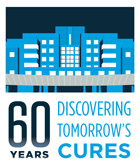 |
60 years of patient-centered basic research
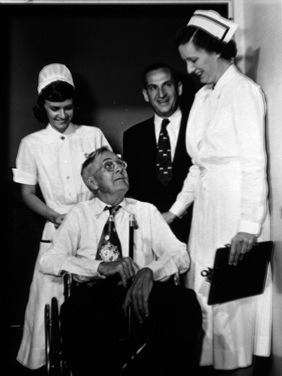 |
The NIH Clinical Center's first patient, Charles Meredith, is admitted on July 6, 1953. |
Charles Meredith, a Maryland farmer suffering from prostate cancer, was the first patient admitted to the NIH Clinical Center. Dr. Roy Hertz was the admitting physician. A few years later, working together with Dr. Min C. Li, Hertz developed the first effective chemotherapy for a solid tumor—methotrexate. Their discovery proved that chemotherapy could cure metastatic cancer, and that an almost uniformly fatal cancer could be cured with a single therapeutic agent. In 1972, Hertz and Li were honored with the Albert Lasker Clinical Medical Research Award for this work.
The NIH Roy Hertz Memorial Research Symposium, organized by the National Institute of Child Health and Human Development, was held in Masur Auditorium on May 17. The event featured scientists, academics, and community-based health care providers discussing a variety of ways—from traditional medicine to genomic research—that the health and research community can work together to improve public health.
Senate Majority Leader Harry Reid visits the
NIH Clinical Center
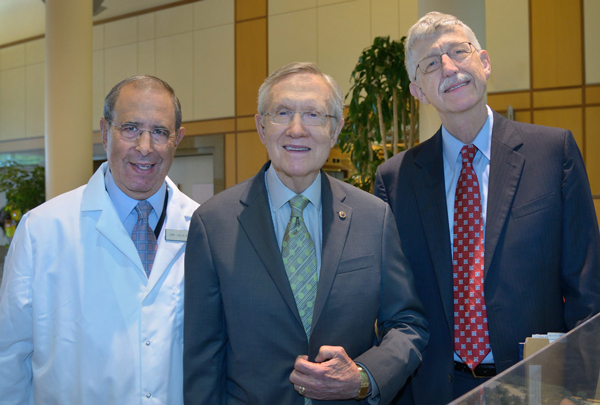 On June 17, Senate Majority Leader Harry Reid (D-NV) paid a visit to the NIH campus, where he met with NIH Director Dr. Francis S. Collins and Clinical Center Director Dr. John I. Gallin. He also met with Dr. Anthony S. Fauci, director of the National Institute of Allergy and Infectious Diseases; Dr. Gary H. Gibbons, director of the National Heart, Lung, and Blood Institute; Dr. Story C. Landis, director of the National Institute of Neurological Disorders and Stroke; and Dr. Cynthia J. Tifft, deputy clinical director of the National Human Genome Research Institute.
On June 17, Senate Majority Leader Harry Reid (D-NV) paid a visit to the NIH campus, where he met with NIH Director Dr. Francis S. Collins and Clinical Center Director Dr. John I. Gallin. He also met with Dr. Anthony S. Fauci, director of the National Institute of Allergy and Infectious Diseases; Dr. Gary H. Gibbons, director of the National Heart, Lung, and Blood Institute; Dr. Story C. Landis, director of the National Institute of Neurological Disorders and Stroke; and Dr. Cynthia J. Tifft, deputy clinical director of the National Human Genome Research Institute.
The next day on the floor of the Senate, Reid expressed his concern about the effects of spending cuts on research efforts at NIH. "I hope we can move forward on this budget conference and get something done to set the nation's financial problems in the right direction," he said. Here Majority Leader Reid is pictured with Drs. Collins and Gallin in the North Atrium of the Clinical Center.
Fusion imaging and cancer treatment
Interventional oncology is a multidisciplinary approach to cancer treatment that offers certain cancer patients effective new options for the treatment of some primary and metastatic cancers. These minimally invasive, image-guided therapies are often far less toxic than the conventional approaches, and can be used along with surgery, radiation and chemotherapy to destroy tumors, often with fewer complications and more rapid recovery than traditional surgical methods.
One exciting new technique is called fusion imaging. Using inexpensive and widely available technology, multiple types of images can be layered together during biopsy or ablation so that an ultrasound camera, needle or catheter can hone in on the target location using the information provided by any prior CT, MRI or PET scan image. Dr. Bradford Wood, director of the Center for Interventional Oncology at the NIH Clinical Center, and his team recently showed that this approach can roughly double the cancer detection rate for certain prostate cancer patients, compared to standard biopsy, and can also improve the targeting of tumors during treatments.
The prostate fusion team—Drs. Wood, Sheng Xu, Hayet Amalou, Jochen Kruecker, Pingkun Yan, and Julie Peretti from the CC's Radiology and Imaging Sciences Department, and Drs. Peter Choyke, Peter Pinto and Baris Turkbey from the National Cancer Institute—has been working together for nearly a decade.
"Fusion can help the physician identify a tumor at risk for under-treatment, under-heating, or under-dosing. It also provides information when it is needed the most, while the patient is still in the procedure room," Wood says. "The bottom line: fusion is low-cost and high-tech."
How does it work? "Actually, it works a lot like a video game," Wood explains. "Local treatments deploy chemotherapy or heat energy only where tumors are imaged, to help prevent systemic complications and side effects. Smart needles have GPS-like position sensors that report the exact location of the needle, image or tumor to the physician, so that energy or drugs can be applied to the correct location, using advanced diagnostic imaging tools. And non-invasive ultrasound waves can heat up cancer tissue to deposit drugs in a prescribed and personalized fashion."
He adds, "Fusion imaging can reduce the time needed for procedures, the radiation dosage, and the complications, which can improve outcomes." For non-aggressive prostate cancer, fusion archives the areas sampled, which can be of tremendous value for active surveillance.
Interventional Oncology is most effective when practiced in a multidisciplinary setting, along with radiation, surgical, medical, and urologic oncology. The CC has been the home for the development of a variety of IO approaches, such as fusion biopsy, fusion ablation, and liver chemoperfusion.
"The integration of software with hardware, coached by biomedical engineers, chemists, software engineers, and imaging experts all coalesce," Wood says. "It's like a symphony of interdisciplinary science that is greater than the sum of its parts."
"Dream" playground for residents opens at
the Children's Inn at NIH
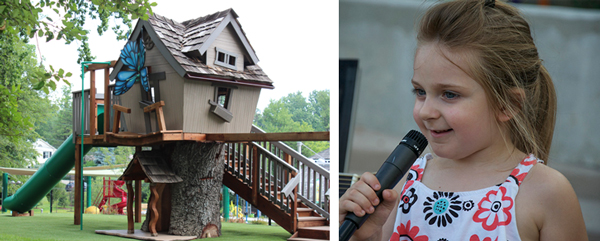 |
Left: A tree house at the Children's Inn. Right: With the accompaniment of a guitar, four-year-old Bella recited the reasons why she liked the new playground: "My favorite part is the fire truck." |
"...a place where healing comes from more than medicines alone." Philip A. Pizzo, MD, Founder of the Children's Inn at NIH
On a beautiful spring day, volunteers, staff, residents and friends of the Children's Inn at NIH gathered to celebrate the opening of a new playground. "Playtime at the Children's Inn is sacred. We take playing very seriously here," said Kathy L. Russell, Chief Executive Officer of the Inn, as she thanked all who had worked so hard, and the outside sources who had contributed so much, to create a playground for children receiving treatment at the Clinical Center. "After a long, hard day of tests and needles, what any kid would want is a place to play," said Dr. Lee J. Helman, Chair of the Inn's Board of Directors and clinical advisor. "This is that place."
As staff and visitors strolled around admiring the playground, happy children began to test the equipment, which includes the usual swings and slides, along with more unique features. A new ramp connects the inside playroom to the playground, facilitating access: those entering from the lower level are greeted by a cheerful kinetic sculpture, "Mama and Baby Giraffe." A tree house includes monkey bars, a tube slide, and a clubhouse. A eucalyptus "Spirit Nest" big enough for a family of four to nestle inside was built onsite, the artist and volunteers weaving branches together. A putting green, a garden kaleidoscope, and interactive musical elements all help create a truly magical place to play.
One of the featured speakers was four-year-old Bella, from New York. "The playground is very nice: I like it!" she said. "My favorite part is the fire truck, and the turtle. And my other favorite parts are the chairs, and the rocks, and the bells, and the grass too."
While no one could blame adults for wanting to spend a little time in this very special place, Clinical Center employees are reminded that the Inn's residents need privacy almost as much as they need a nice place to play. For this reason, and also because many Inn residents are severely immune-compromised, the playground is for their use only.
Clinical Center staff promotes the importance of hand hygiene
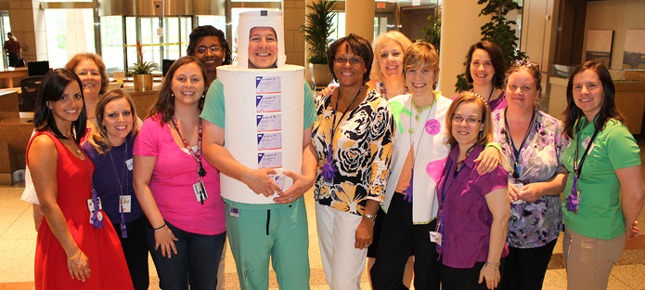 |
HHIIT team at the second annual I ♥ Clean Hands Day in the Clinical Center atrium. |
To raise awareness and promote the ease and importance of practicing good hand hygiene, Clinical Center staff, patients, and their families were invited to the second annual I ♥ Clean Hands Day. The event, organized by the CC Hand Hygiene Isolation Innovation Team, was held May 21in the CC atrium.
"We want hand hygiene to be an integral, automatic part of the health care culture for all staff members, and one that deserves celebration on its own day once a year," explained Dr. Tara Palmore, deputy hospital epidemiologist for the Clinical Center.
The CC staff, patients, and visitors enjoyed a variety of activities, including a fact-fiction game wheel, demonstration booths for proper hand washing, microbiology exhibits, and fun crafts. One popular booth invited attendees to sample and vote for their favorite hand lotion.
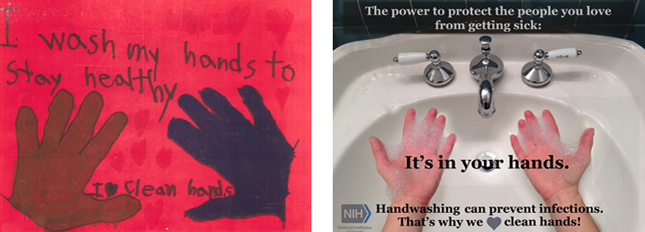 |
Left: CC patient Hunter Liszewski's entry won the pediatric promotional poster contest. Right: Michelle Holshue's poster took first place in the adult contest. |
A poster contest brought together staff, patients and family members with more than 40 entries submitted. Attendees voted for their favorite posters, and the winners were announced at the end of the event. Hunter Liszewski, a seven-year-old patient from New Hampshire received first place among pediatric contestants. Michelle Holshue, a clinical research nurse from the eighth floor outpatient clinic, was awarded first place in the adult contest.
"I came up with 'The Power Is In Your Hands' because I wanted to convey that this small, often overlooked act can really make a huge difference in reducing the spread of disease. It's an important message—not just for health care providers—but for patients and their families too," said Holshue. The winning posters were displayed in the CC atrium for several days after the event and will be used in the continued hand hygiene campaigns throughout the Clinical Center.
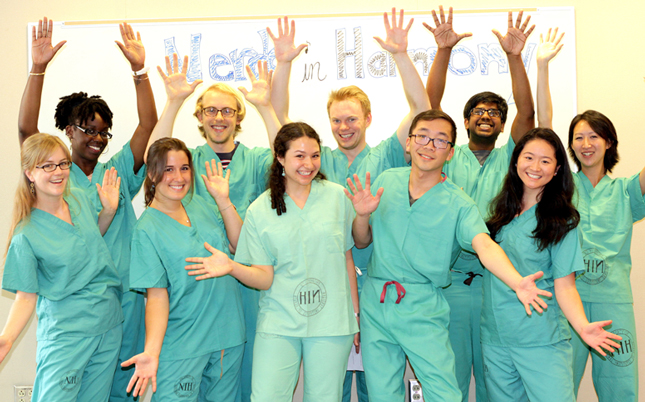 |
The NIH Nerds in Harmony performed at the second annual I ♥ Clean Hands Day. |
The NIH Nerds in Harmony, an a cappella group of singing scientists added to the festivities, singing new lyrics about proper hand hygiene to familiar old tunes.
According to Laura Lee, special assistant to the Deputy Director of Clinical Care, "Hand hygiene is one of the most important patient safety activities that we, as health care providers, can do for our patients. Twenty seconds really can save a life!" For more information visit http://www.cdc.gov/handhygiene/.
Carderock Springs Elementary raises funds for
children at the CC
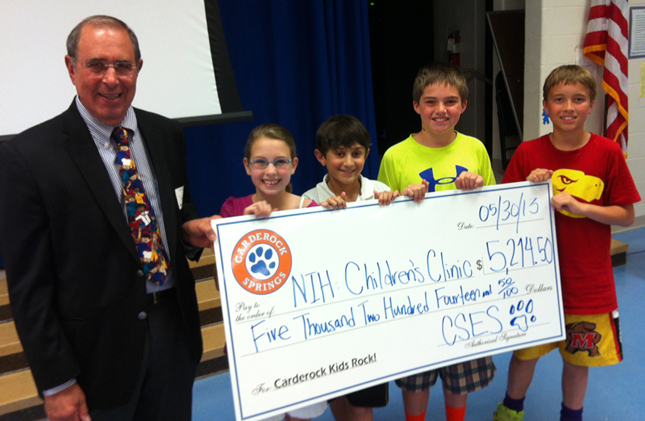 |
Officers of the Carderock Springs Elementary School Student Government Association present CC Director Dr. John I. Gallin with their donation. "The children at the NIH Clinical Center are the major beneficiaries of this wonderful gift," said Gallin. |
Matthew Ghaman, a fifth-grade teacher at the Carderock Springs Elementary School wanted to do something different with the Student Government Association (SGA) officers he advises. "SGA had become primarily about the election," he says. "I hoped to shift our focus to after the elections. Now that the voting excitement had ended, what could our SGA do to lead us toward working hard and giving back?"
Last spring, Ghaman suggested to the student SGA officers that they organize a fundraising drive. "If you were to do that, what cause would you like to support?" he asked them. They decided they would like to do something for children at the NIH Clinical Center. And they were off!
They decided they would sponsor a "Penny Wars." They organized the school into competitive teams, with children from all classrooms bringing in spare change and doing the calculations. (Pennies added points to each team's score, while silver coins and bills subtracted from them.) Last year they raised $2,823.33: that was pretty impressive. But this year, they brought in an astounding $5,214.50, in just a week! "If people could only see the outpouring of energy and commitment that went into this," Ghaman says. "It was awesome."
The funds raised were donated to the CC Patient Emergency Fund, a program operated through the Social Work Department that provides periodic limited emergency financial assistance to selected patients and family members. Asked what the best part of the drive was, one of the SGA officers said, "Knowing that we raised money for kids that have cancer, and that we helped them when they really needed it." Another said, "It made me feel good, and also proud." What would they tell children at other schools who might consider taking on a similar project? "I would tell them that it's really fun, and it makes you feel good to help other people, but you have to be prepared to count A LOT of pennies!" said another.
And when asked what they had learned from the experience, one of them summed up the experience by saying, "I learned that a lot of hard work can turn into the greatest feeling that you've ever had!"
Project SEARCH interns, serving NIH and the
Clinical Center with pride
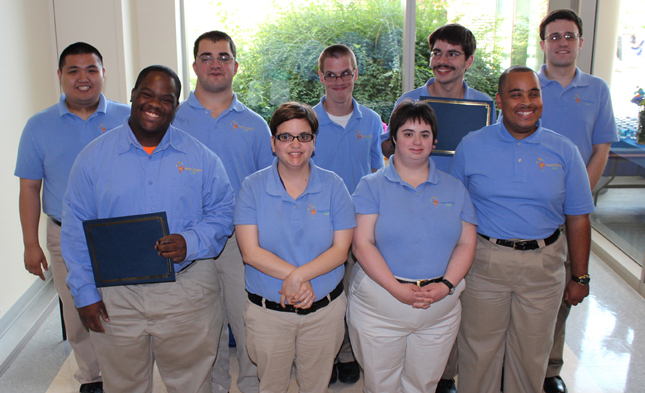 |
NIH Project SEARCH graduates, 2013. Front Row from left: Keith Manning, Gabriela Nugent, Meghan Jones, Brent Atwater Back row from left: James Garcia, Alex Shapiro, Mark McNeel, Nicholas Logan, Charles Niedner. Not pictured: Jeremy Williams. |
In 2010 NIH launched an exciting new partnership with Project SEARCH, a nationwide program that provides young adults who have intellectual disabilities with an invaluable experience: immersion in the workplace, and the chance to build marketable skills for employment.
On June 5, the third group of Project SEARCH interns was honored with a graduation ceremony marking their successful completion of the program. In her welcoming remarks, Denise Ford, director of Patient and Guest Relations, noted the "commonality of commitment and purpose" the interns bring to their work at NIH, as well as the energy and joy they bring to the workplace.
"You should all be very proud," said Clinical Center Director John I. Gallin. "It is very rewarding to watch the progress you have made, and to congratulate you for the good work you've done."
In the first three years of Project SEARCH at NIH, 32 interns have completed the program: 20 of them have been hired within NIH, 12 at the Clinical Center. "These are ultra-passionate, ultra-caring, hardworking people," said Don Lonnerdal, CIO of the NIH Office of Research Services (ORS), where three of this year's interns were hired.Eleven institutes and centers are now actively mentoring interns and, inspired by the success of the program at NIH, new programs are being launched in Montgomery County government and at the Smithsonian.
This year, seven of the ten graduates were hired at NIH, two of them in the CC. Gabriela Nugent works as a hand sanitizer clerk in MMESD, where her supervisor is Joann Bellinger, Lead Inventory Management Specialist. "Gaby's energetic and she loves people," Bellinger says. "If you're not in a good mood, she'll put you in a good mood."
Brent Atwater delivers medications for the Pharmacy. When asked what he would tell others about Project SEARCH, he says, "It's a good opportunity. It's nice people at the Clinical Center." Alex Gurevich, IV Room Supervisor, has nothing but praise for Atwater in return. "I'm very impressed with him. He does a great job. He's always punctual, always in a good mood. We just love him."
Visit http://www.projectsearch.us/ [disclaimer] to learn more about Project SEARCH.
Alice Smyth recognized for 40 years of service
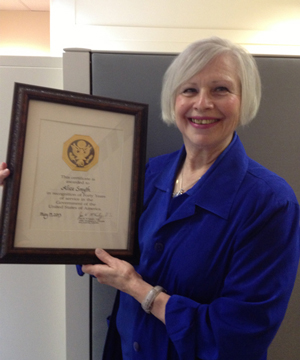 The Department of Clinical Research Informatics recognized Alice "Frankie" Smyth for her 40 years of dedication and commitment to NIH and DCRI.
The Department of Clinical Research Informatics recognized Alice "Frankie" Smyth for her 40 years of dedication and commitment to NIH and DCRI.
Smyth started at the Clinical Center as a nurse in the Neurology service. After two years, she was asked to represent that service in the preparation and implementation of NIH's first Medical Information System, also known as MIS. A one-year detail turned into a 38-year career in Nursing Informatics. Smyth is one of the original MIS Cadre members, and has dedicated much of her life in the training and support of all NIH's healthcare workers using the MIS and the Clinical Research Information System (CRIS).
DCRI truly appreciates all that Smyth has done to support the NIH Mission and thanks her for her 40 years of service.
Introducing the CC Patient Portal
Coming soon! The Clinical Center will soon implement a secure, web-based Patient Portal, which will provide patients with access to view selected information from their electronic medical records. The Patient Portal, scheduled to launch this month, will initially provide key information about the NIH and the Clinical Center, as well as access for patients to view selected results and limited clinical documentation.
As the site is used and evaluated, additional information will be made accessible via the Patient Portal in a view-only format, including additional clinical documentation, medication lists, registration information and appointments.
By the end of the year, patients will also be able to initiate secure communication with their NIH health care providers through the Patient Portal. Be on the lookout for additional information and demonstrations of the Patient Portal. This is very exciting for the Clinical Center, as we work to involve our patients as true partners in research.
For general information about the Clinical Center's Patient Portal, please contact the Medical Record Department's Patient Portal Support Team at 301-594-5725 or 1-855-644-6445.
Volunteers wanted for liver study
NIDDK seeks volunteers 18 and older with non-alcoholic fatty liver disease (NAFLD) or non-alcoholic steatohepatitis (NASH). Researchers want to know which dose of vitamin E most effectively treats these conditions.
Throughout the study, a registered dietitian will provide counseling to help achieve and maintain the diet and lifestyle changes. Study-related tests, procedures, and medications are provided at no cost. For more information, call 1-866-444-2214 (TTY 1-866-411-1010) and refer to study 13-DK-0002.

NIH Clinical Center marks 60 years
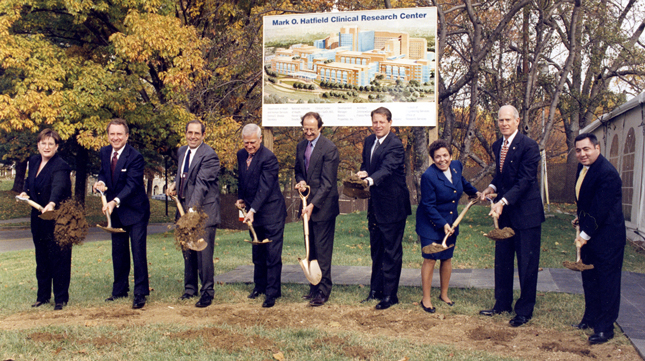 |
On November 4, 1997, ground was broken for the new Mark O. Hatfield Clinical Research Center. Present were, L to R: Former CC patient Jane Reese-Coulbourne; Sen. Arlen Specter (R-Pa); CC Director Dr. John I. Gallin; Sen. Mark O. Hatfield (R-Ore); NIH Director Dr. Harold Varmus; U.S. Vice President Al Gore; HHS Secretary Donna Shalala; Rep. John Porter (R-Ill); and CC patient Charles Tolchin. The building was dedicated in 2004. |
The first patient was admitted to the Clinical Center in 1953, but our story begins long before that. In one sense, it begins with the founding of the Public Health Service in 1798; in another, with medical advances made during World War II.
"The development of penicillin...and the search for malaria treatments launched a revolution in clinical medicine, tying laboratory medicine to the clinician," Pat McNees wrote on the occasion of our fiftieth anniversary, in Building Ten at Fifty. Between 1945 and 1955, deaths from influenza, pneumonia, syphilis and diphtheria fell rapidly. "Congress and the public began to believe that medical science could do anything, given the right resources."
In this climate three visionary Public Health Service officers—Thomas Parran, Lewis R. Thompson, and Rolla E. Dyer—guided the 1944 Public Health Service Act through Congress, setting the stage for one of the most exciting periods in the history of medicine. The intramural NIH Program, centered on patients in the Clinical Center, was destined to begin. "The NIH mandate would be to produce not new knowledge for the sake of new knowledge, but new knowledge that led to prevention, treatments and, where possible, cures," McNees wrote. The building itself was revolutionary, specifically designed to bring about the kind of scientific collaboration for which the CC has since become famous: "We wanted to have a physical situation in which specialists in many disciplines...would be thrown into contact with each other in the elevators, at the luncheon table, at seminars, and meetings," said Dr. Jack Masur, the Clinical Center's first director.
In the beginning, efforts at the Clinical Center were concentrated on fighting cancer, heart disease and other major killers. In 1957, the first successful chemotherapy treatment for a solid tumor was developed here, paving the way for vast improvements in the treatment of other cancers. In 1973, the first national guidelines for the prevention and treatment of heart disease were based on studies by Clinical Center dietitians working with NHLBI researchers.In 1984, the first MRI unit became operational for patient imaging; in 1990, the first gene therapy treatment was introduced; and in 2007, the first patient in the human genome sequencing study was enrolled.
Today the Clinical Center leads the world in the study of rare diseases which, as any Clinical Center physician will tell you, often yields information that leads to improvements in health for everyone.
In 1984, physician-scientist Lewis Thomas wrote, "NIH is not only the largest institution for biomedical science on earth; it is one of this nation's great treasures. As social inventions for human betterment go, [it] is...proof that...government possesses the capacity to do something unique, imaginative, useful, and altogether right."
As we celebrate this anniversary, exciting new research efforts are on the horizon, just one of them the BRAIN initiative announced earlier this year. Looking to the future, we anticipate that research will increasingly shift from the treatment of chronic diseases to predicting illness before it occurs, and personalizing therapies.
We invite you to join us in celebrating 60 years of discovering tomorrow's cures, as well as the continuing work of turning discovery into health.
60th Anniversary Clinical Center Grand Rounds
Contemporary Clinical Medicine: Great Teachers
July 10, 2013
12 Noon – 1:30 pm
Research Milestones: 60 Years of Clinical Research
John I. Gallin, MD
Director, NIH Clinical Center
The Human Mammary Tumor Virus
James F. Holland, MD ScD
Distinguished Professor of Neoplastic Diseases
Icahn School of Medicine at Mount Sinai, New York
Location, Location, Location: The Mycobacterial Susceptibility Story
Steven M. Holland, MD
Chief, Laboratory of Clinical Infectious Diseases, NIAID
Deputy Director for Intramural Clinical Research, NIH
This special Grand Rounds event will be held in Masur Auditorium.
The Clinical Center's last big anniversary celebration was in 2003. So much has happened in the past ten years. Visit www.cc.nih.gov/about/news/annivers60.shtml to see many more highlights.
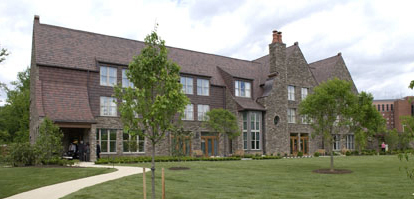 | 2005 The Edmond J. Safra Family Lodge opens. Its guest rooms provide a comforting home away from home for families and caregivers of patients who participate in clinical research at the NIH Clinical Center. |
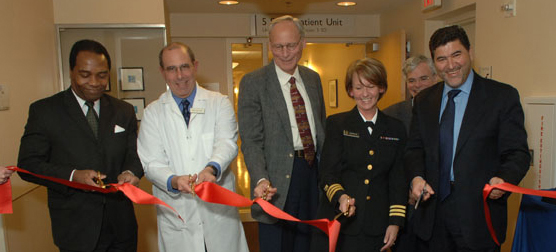
2007 The Metabolic Clinical Research Unit opens. This state-of-the-art research unit helps experts in the fields of metabolism, endocrinology, nutrition, cardiovascular biology, gastroenterology, hepatology, genetics and behavioral sciences generate new knowledge regarding the physiology, prevention, and treatment of obesity. Designed to support researchers investigating diseases such as diabetes, high blood pressure, high cholesterol and certain types of cancer, the MCRU is a key component of the NIH Strategic Plan for Obesity Research. (L to R) Dr. Griffin Rodgers, NIDDK director; CC Director Dr. John I. Gallin; Dr. Marvin Gershengorn and Dr. Monica Skarulis, NIDDK senior researchers; Dr. Michael Gottesman, NIH deputy director for Intramural Research; and Dr. Elias A. Zerhouni, NIH director.
2010 The CC's Pharmaceutical Development Section (PDS) upgrades to a new, state-of-the-art facility in which vaccines and medications that can't be purchased from manufacturers are formulated and analyzed. PDS also registers and packages all drugs obtained for outside pharmaceutical companies for use in clinical trials. |
|
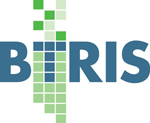 | 2009 Biomedical Translational Information System (BTRIS) is launched. BTRIS plays a key role in redefining the way researchers can use and access data at NIH, while continuing to protect the privacy of human subjects. |
2003 The Office of Clinical Research Training and Medical Education is established to centralize research training and medical education, and to support the CC's mission to train the next generation of medical researchers and clinician-scientists by providing clinical research training to individuals of varying education levels and professional backgrounds. Through OCRTME's training opportunities high school and graduate students, medical and dental students, experienced researchers and health professionals all have the opportunity to participate in programs and courses that provide exceptional professional growth experiences. | 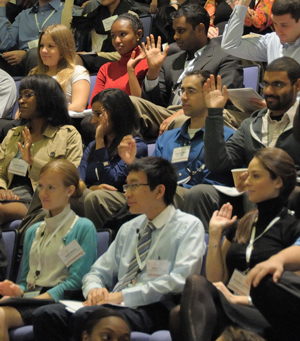 |
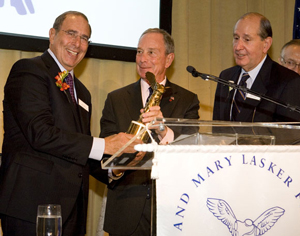 | 2011 The Clinical Center is honored with the 2011 Lasker-Bloomberg Public Service Award. Pictured here, Dr. John I. Gallin, CC director, accepts the award from New York City Mayor Michael Bloomberg (middle) and Alfred Sommer, Lasker Foundation chair. The award honors the CC for serving as a model institution that has transformed scientific advances into innovative therapies and for providing high-quality care to patients; spearheading major advances in a wide array of medical arenas; establishing an example for academic institutions across the country; and training thousands of investigators. The award also acknowledges the CC and the NIH's rich history of medical discovery through clinical research since the hospital opened in 1953. |
Advancing clinical research remains our primary mission, but the Clinical Center itself constantly evolves, just like the research that occurs within its walls. Visit www.cc.nih.gov/about/news/annivers60.shtml to see these photos and many more.
| ||||
| ||||
|
Over the next several months, CC News is pleased to bring you historical perspectives on the Clinical Center's important work from throughout the community.
Henry Masur, MD |
Christine Grady, MSN, PhD |
Robert Hedetniemi, CEC |
Adrienne Farrar, PhD, LCSW-C |
|
|
 The information on this page is archived and provided for reference purposes only.
The information on this page is archived and provided for reference purposes only.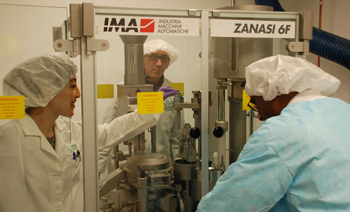
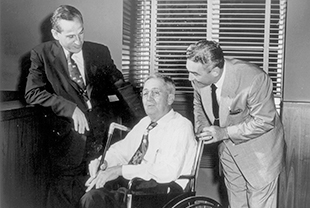
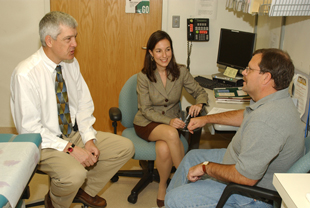
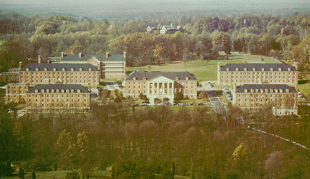
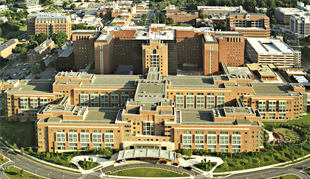
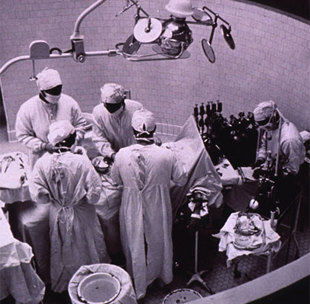
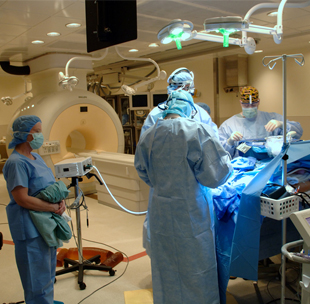
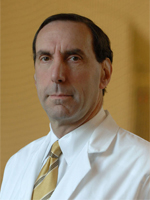 "The intramural program at NIH has opportunities unmatched at other institutions: freedom to initiate new programs without onerous and lengthy pre-approval, access to thousands of world-class scientists, and a hospital where patient care and clinical research are the primary priorities. The intramural program has not only launched many successful careers, but it has been a long-term home for many of us. For me, working on new interventions to improve AIDS care, developing national HIV/AIDS guidelines for health care, developing a model for urban HIV care in the District of Columbia, managing a state-of-the-art ICU, and training bright, energetic leaders has been more than enough reason to remain at NIH."
"The intramural program at NIH has opportunities unmatched at other institutions: freedom to initiate new programs without onerous and lengthy pre-approval, access to thousands of world-class scientists, and a hospital where patient care and clinical research are the primary priorities. The intramural program has not only launched many successful careers, but it has been a long-term home for many of us. For me, working on new interventions to improve AIDS care, developing national HIV/AIDS guidelines for health care, developing a model for urban HIV care in the District of Columbia, managing a state-of-the-art ICU, and training bright, energetic leaders has been more than enough reason to remain at NIH."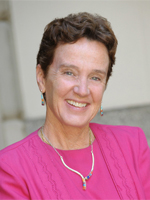 "It has been a true privilege to work at the NIH Clinical Center in my roles as clinical nurse specialist, investigator, IRB member, and bioethicist. From its beginning, the CC has been a leader in ethical research and efforts to protect human subjects. Remarkable people at the CC continue to uphold the highest ethical and scientific standards for research, from scientists making path-breaking discoveries at the bench, to the research teams studying human illnesses and interventions. The clinical staff provides excellent care to research participants, the support staff keeps it all running, and the research participants are vital partners in this significant endeavor."
"It has been a true privilege to work at the NIH Clinical Center in my roles as clinical nurse specialist, investigator, IRB member, and bioethicist. From its beginning, the CC has been a leader in ethical research and efforts to protect human subjects. Remarkable people at the CC continue to uphold the highest ethical and scientific standards for research, from scientists making path-breaking discoveries at the bench, to the research teams studying human illnesses and interventions. The clinical staff provides excellent care to research participants, the support staff keeps it all running, and the research participants are vital partners in this significant endeavor." "It is truly a privilege to be part of such a professional group of individuals where my contributions are welcomed and may help to impact the quality of patient care while here at the Clinical Center.
"It is truly a privilege to be part of such a professional group of individuals where my contributions are welcomed and may help to impact the quality of patient care while here at the Clinical Center.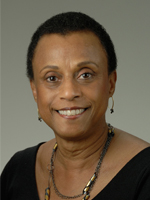 "I have worked at the CC for over 20 years and the experience has been endlessly fascinating, having worked with some of the most talented and committed interdisciplinary professionals in the country and the world. Hopefully, I have developed a social work department that consistently delivers expert services with skill, expertise, and compassion. I am very proud of my staff of social workers and language interpreters—they do amazing things every day! It has also been a pleasure to work with so many generous volunteers of all backgrounds and ages, who so graciously give their time and talents to our patients."
"I have worked at the CC for over 20 years and the experience has been endlessly fascinating, having worked with some of the most talented and committed interdisciplinary professionals in the country and the world. Hopefully, I have developed a social work department that consistently delivers expert services with skill, expertise, and compassion. I am very proud of my staff of social workers and language interpreters—they do amazing things every day! It has also been a pleasure to work with so many generous volunteers of all backgrounds and ages, who so graciously give their time and talents to our patients." Susan Lowell Butler called the Clinical Center, "the magical place where science and compassion come together to save our lives." When Butler was diagnosed with simultaneous breast and ovarian cancer, she came to NIH for treatment, and achieved remission in both cancers. Butler served on NCI’s first consumer advocacy board and the NIH Clinical Center’s Patient Advisory Group, and was a co-founder of the Ovarian Cancer National Alliance. Here she is with President Obama during a Presidential visit to the Clinical Center. Susan Lowell Butler died of ovarian cancer in 2010, fifteen years after her diagnosis.
Susan Lowell Butler called the Clinical Center, "the magical place where science and compassion come together to save our lives." When Butler was diagnosed with simultaneous breast and ovarian cancer, she came to NIH for treatment, and achieved remission in both cancers. Butler served on NCI’s first consumer advocacy board and the NIH Clinical Center’s Patient Advisory Group, and was a co-founder of the Ovarian Cancer National Alliance. Here she is with President Obama during a Presidential visit to the Clinical Center. Susan Lowell Butler died of ovarian cancer in 2010, fifteen years after her diagnosis.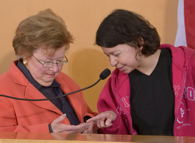 Felicia Sanchez has severe coccidioidomycosis (Valley Fever), a rare disease caused by a fungal infection that enters the body through the lungs. In March, at a press conference Sanchez told the story of how she had been told by her doctors that there was nothing they could do for her. "Within a month of coming here, I was better," she said. "I could go home again and enjoy my life. NIH gave me back something I had lost—it gave me hope." Here she gives Senator Barbara Mikulski (D-MD) a memento, after sharing her story with the press.
Felicia Sanchez has severe coccidioidomycosis (Valley Fever), a rare disease caused by a fungal infection that enters the body through the lungs. In March, at a press conference Sanchez told the story of how she had been told by her doctors that there was nothing they could do for her. "Within a month of coming here, I was better," she said. "I could go home again and enjoy my life. NIH gave me back something I had lost—it gave me hope." Here she gives Senator Barbara Mikulski (D-MD) a memento, after sharing her story with the press.